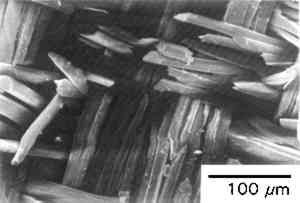Shattered Silk, Tragic Beauty
- The Bunch Bloggers
- Dec 18, 2019
- 2 min read
During the mid-19th to early-20th centuries, silk was often artificially weighted by producers with metallic salts to add a desirable heavy hand, luxurious drape, an ear-catching rustle, and a sumptuous sheen. As silk has been historically sold wholesale by weight, cheaper silks could fetch a higher price if they were treated in this fashion. However, the additional price tag bought you only the pretense of quality. After only a few years, or even months of wear, garments made with weighted silk would begin to degrade in an inevitable process called shattering. The tensile strength of the silk threads was compromised by the sharp salts used for weighting. Overtime, these salts would begin to act like minuscule razors, slicing apart the
the weakened weave of the fabric. Shattered silk spontaneously tears itself to shreds. Men’s ties shattered at the knot points and the sleeves of women’s gowns ripped and tore without cause. Public outrage would eventually lead to laws passed by the U.S. Federal Trade Commission, requiring silk weighted more than 10% to be so labeled by the manufacturer. Eventually, producers stopped making it all together.
Lot 1929 from our upcoming January 7th sale is a great example of how shattered silk can be conserved for the enjoyment of future generations. These four embroidered silk panels, depicting the seasons with magnolia, lotus, chrysanthemum, and plum floral motifs, have been lovingly maintained through careful restorative efforts.

Although there are areas of complete disintegration where the backing fabric is utterly exposed, many of the more fragile elements of these silk panels-- the weave that is actively shattering-- has been stabilized with painstaking couched stitches. Areas of newer shatter are apparent and inevitable. Each time I handled these, despite the utmost care, new splits appeared. I was thankful for the sheer layer of sepia silk crepeline that had been stitched into place over each panel, as this minimized the movement and abrasion of areas just beginning to tear, and those that must have started sometime after these conservation efforts were taken.

Because the crystalline salts are chemically bound to the fibers as a result of weighting, the process cannot be reversed. Shattering is inherently progressive-- these panels were doomed the moment a weighted silk was chosen as the background material-- and they will only continue to degrade over time. Even so, they maintain the ghostly appeal of peeled wallpaper or chipped paint. In their current “restored” condition they could still be used for display as window coverings or wall hangings.

If you are a collector with preservation in mind, however, the best storage practice for these and other shattered silks would be for the piece to be laid flat, either in a box or in a drawer, and to be wrapped in acid free tissue. Both sunlight and artificial light accelerate the chemical reactions that cause the metallic salts to split fibers. Folding should be limited as much as possible (these panels would probably do well rolled) as this would create a points of stress for the silk to shatter on. Even ill-fated pieces such these panels deserve to be collected, cataloged, and enjoyed.



















































I found matlab assignment help useful while practicing MATLAB problems, especially for understanding logic errors and improving my coding approach.
Скачайте последнюю версию нулс бравл скачать и играйте на приватном сервере Brawl Stars с неограниченными кристаллами, монетами и ящиками. Откройте всех бойцов, устраивайте собственные матчи и наслаждайтесь эксклюзивными функциями вместе с друзьями бесплатно.
Great article! thanks for sharing! Just like Devil Slash Youth Puffer Hoodie, it’s bold, impactful, and ready to make a statement.
It is common for players to experience an increase in self-assurance after using Golf Orbit since they are aware that they are able to conquer the demands of the golf course with ease and precision.
Een meeslepende roman als “Shattered Silk, Tragic Beauty” onthult hoe kwetsbaarheid en kracht elkaar kunnen kruisen in één verhaal.
Bij B7 Gokken ontdek je een elegante mix van moderne spellen en royale bonussen, waardoor iedere speler zich welkom voelt. Dankzij de snelle uitbetalingen en het gebruiksvriendelijke platform wordt je spelervaring hier meteen plezierig en betrouwbaar.